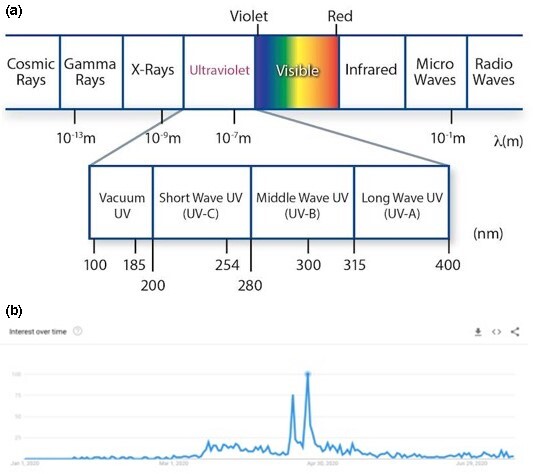The rapidly evolving knowledge base surrounding the COVID‐19 pandemic has led to anxiety and cognitive dissonance. Misinformation about the role of ultraviolet (UV) radiation has spread rapidly, including statements from the President of the USA in April 2020. Myths related to SARS‐CoV‐2 and UV radiation are being widely shared on social media,1 with #uvKillsCovid19 and #UVdisinfection emerging as new search terms on Twitter. It has erroneously been claimed that sunlight and tanning beds, which contain UVA and UVB, eradicate COVID‐19 via UV radiation.2
However, UVA and UVB are poorly virucidal. The sunlight that reaches earth contains only UVA and UVB, and is ineffective in eradicating SARS‐CoV‐2. UVC is a shorter wavelength (Fig. 1), and is absorbed by atmospheric ozone, but manmade sources exist. Even a very brief exposure to UVC induces photodimerization of thymine, therefore disrupting nucleic acid replication and rendering micro‐organisms nonviable.3
Figure 1.

(a) The electromagnetic spectrum with ultraviolet (UV) highlighted. (b) Interest over time for search term ‘sunlight coronavirus’ on Google Trends.
Analysis of Google Trends shows that the search term ‘sunlight coronavirus’ had exponential growth in April 2020 (Fig. 1b), with a relative search index of 100 on 24 April 2020. The search ‘sunlight kill coronavirus’ is one of the highest trending Google searches related to COVID‐19 globally.
Tanning salons have tried to remain open in several countries during the pandemic by claiming that their devices destroy SARS‐CoV‐2. Tanning beds use UVA for immediate tanning and UVB for delayed tanning, emitting no UVC whatsoever,4 thus this claim is erroneous.
Meanwhile, UV disinfection lamps have been marketed as hand sanitizers.2 These germicidal lamps use UVC and are toxic to the human skin and cornea, potentially causing radiation dermatitis, skin cancer and visual impairment.
Germicidal irradiation using UVC may have a role in the fight against COVID‐19 as a useful mechanism to disinfect and reuse personal protective equipment as well as for sterilization of medical instruments.5 UVC germicidal bulbs may also be useful in the disinfection of air and water but should not be used in any application with potential exposure to humans.
Multiple myths are circulating about the role of UV radiation against SARS‐CoV‐2. It is important to highlight the ineffective nature of UVA and UVB and the potentially harmful nature of UVC.
Contributor Information
C. O'Connor, Department of Dermatology South Infirmary Victoria University Hospital Cork Ireland University College Cork Cork Ireland.
C. Courtney, Department of Dermatology South Infirmary Victoria University Hospital Cork Ireland
M. Murphy, Department of Dermatology South Infirmary Victoria University Hospital Cork Ireland University College Cork Cork Ireland.
References
- Gorvett Z. Can you kill coronavirus with UV light? Available at: https://www.bbc.com/future/article/20200327‐can‐you‐kill‐coronavirus‐with‐uv‐light (accessed 28 April 2020).
- World Health Organization. Coronavirus disease (COVID‐19) advice for the public: mythbusters. Available at: https://www.who.int/emergencies/diseases/novel‐coronavirus‐2019/advice‐for‐public/myth‐busters (accessed 28 April 2020).
- Dai T, Vrahas MS, Murray CK, Hamblin MR. Ultraviolet C irradiation: an alternative antimicrobial approach to localized infections? Expert Rev Anti Infect Ther 2012; 10: 185–95. [DOI] [PMC free article] [PubMed] [Google Scholar]
- World Health Organization. Ultraviolet radiation and the INTERSUN Programme. UV radiation. Available at: https://www.who.int/uv/faq/sunbeds/en/index2.html (accessed 28 April 2020).
- Narla S, Lyons AB, Kohli I et al. The importance of the minimum dosage necessary for UVC decontamination of N95 respirators during the COVID‐19 pandemic. Photodermatol Photoimmunol Photomed 2020; 36: 324–5. [DOI] [PMC free article] [PubMed] [Google Scholar]


